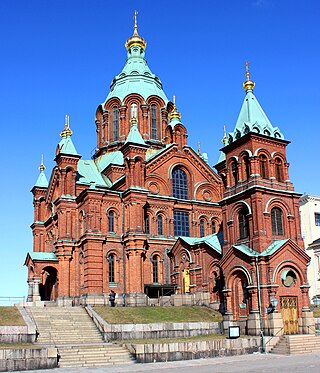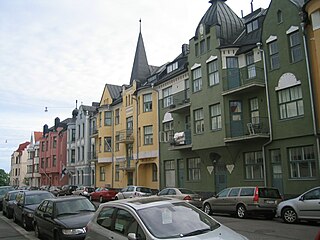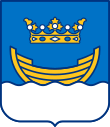
Suomenlinna, or Sveaborg, is a sea fortress composed of eight islands, of which six have been fortified; it is about 4 km southeast of the city center of Helsinki, the capital of Finland. Suomenlinna is popular with tourists and locals, who enjoy it as a picturesque picnic site. Originally named Sveaborg, or Viapori as referred to by Finnish-speaking Finns, it was renamed in Finnish to Suomenlinna in 1918 for patriotic and nationalistic reasons, though it is still known by its original name in Sweden and by Swedish-speaking Finns. Due to its strategic geographical location, it sometimes used to be known as Gibraltar of the North.

The Orthodox Church of Finland or Finnish Orthodox Church is an autonomous Eastern Orthodox archdiocese of the Ecumenical Patriarchate of Constantinople. The church has a legal position as a national church in the country, along with the Evangelical Lutheran Church of Finland.
Helsinki is the capital of Finland and is its largest city. It was founded in the Middle Ages to be a Swedish rival to other ports on the Gulf of Finland, but it remained a small fishing village for over two centuries. Its importance to the Swedish Kingdom increased in the mid-18th century when the fortress originally known as Sveaborg was constructed on islands at the entrance to the harbor. While intended to protect Helsinki from Russian attack, Sveaborg ultimately surrendered to Russia during the Finnish War (1808-1809), and Finland was incorporated into the Russian Empire as part of the Treaty of Fredrikshamn. Russia then moved the Finnish capital from Turku to Helsinki, and the city grew dramatically during the 19th century. Finnish independence, a civil war, and three consecutive conflicts associated with World War II made Helsinki a site of significant political and military activity during the first half of the 20th century. Helsinki hosted the Summer Olympic Games in 1952, was a European Capital of Culture in 2000, and the World Design Capital in 2012. It is considered a Beta Level city by the Globalization and World Cities Research Network (GaWC), according to their 2012 analysis.

The Ivan the Great Bell Tower is a church tower inside the Moscow Kremlin complex. With a total height of 81 metres (266 ft), it is the tallest tower and structure of the Kremlin. It was built in 1508 on Cathedral Square for the three Russian Orthodox cathedrals, namely the Assumption, the Archangel and the Annunciation, which do not have their own belfries. It serves as a part of Moscow Kremlin Museums.

Helsinki Cathedral is the Finnish Evangelical Lutheran cathedral of the Diocese of Helsinki, located in the neighborhood of Kruununhaka in the centre of Helsinki, Finland, at the Senate Square. The church was originally built from 1830 to 1852 as a tribute to the Grand Duke of Finland, Emperor Nicholas I of Russia. It was also known as St Nicholas's Church until Finland declared its full independence in 1917. It is a major landmark of the city, and one of the most famous historical structures in Finland as a whole when viewed globally.

Kazan Cathedral or Kazanskiy Kafedralniy Sobor, also known as the Cathedral of Our Lady of Kazan, is a cathedral of the Russian Orthodox Church on the Nevsky Prospekt in Saint Petersburg. It is dedicated to Our Lady of Kazan, one of the most venerated icons in Russia.

St. Alexander Nevsky Cathedral is a Bulgarian Orthodox cathedral in Sofia, the capital of Bulgaria. Built in Neo-Byzantine style, it serves as the cathedral church of the Patriarch of Bulgaria and it is one of the 50 largest Christian church buildings by volume in the world. It is one of Sofia's symbols and primary tourist attractions. St. Alexander Nevsky Cathedral in Sofia occupies an area of 3,170 square metres (34,100 sq ft) and can hold 5,000 people inside. It is among the 10 largest Eastern Orthodox church buildings. It is the largest cathedral in the Balkans. It is believed that up until the year 2000 it was the largest finished Orthodox cathedral.

The Alexander Nevsky Cathedral of Tallinn is an Eastern Orthodox cathedral in central Tallinn, Estonia. It was built in 1894–1900, when the country was part of the former Russian Empire. The cathedral is the city's largest cupola church. The late Patriarch Alexy II of Moscow (1929–2008) started his priestly ministry in the cathedral. It is the primary cathedral of the semi-autonomous Estonian Orthodox Church of the Moscow Patriarchate.

Uspenski Cathedral is a Greek Orthodox or Eastern Orthodox cathedral in Helsinki, Finland, and main cathedral of the Orthodox Church of Finland, dedicated to the Dormition of the Theotokos. Its name comes from the Old Church Slavonic word uspenie, which denotes the Dormition. It is the largest Greek Orthodox church in both Northern and Western Europe.

Kuivasaari is a Finnish island in the Gulf of Finland, near Helsinki.

David Ivanovich Grimm was a Russian architect, educator and historian of art specialising in the Byzantine Empire, Georgia and Armenia. Grimm belonged to the second generation of Russian neo-Byzantine architects and was the author of Orthodox cathedrals in Tbilisi, Chersonesos and smaller churches in Russia and Western Europe. Grimm was a long-term professor at the Imperial Academy of Arts and chaired its department of architecture in 1887–1892.

Harmaja is an island and a lighthouse outside Helsinki, south of the Suomenlinna sea fortress. The island has been functioning as a landmark since the 16th century. A landmark structure was built on the island in the 18th century and a light house in 1883. The first lighthouse was only 7.3 m high and it soon proved to be too low. In 1900 the height was doubled by creating a rectangular brick building on a granite base. A large foghorn alerted ships in fog and in bad visibility. Harmaja received the world's first directed and undirected radio beacon in 1936. The lighthouse is fully automated today.

Ullanlinna is a city district of Helsinki, in Finland. The name Ullanlinna refers to the fortification line that was built at the southern edge of the area during the 18th century, as part of the town fortifications, which also included the fortress of Suomenlinna. The name Ulla refers to the Swedish Queen Ulrika Eleonora (1688–1741). During the 19th century the area was dominated by summer pavilions owned by the wealthy Helsinki middle-classes. The appearance of the area changed gradually at the end of the 19th century as the wooden houses were replaced with much higher stone buildings, designed in the prevailing Jugendstil architectural style synonymous with National Romanticism.

The Krepost Sveaborg was an Imperial Russian system of land and coastal fortifications constructed around Helsinki during the First World War. The purpose of the fortress was to provide a secure naval base for the Russian Baltic fleet and to protect Helsinki and block routes to Saint Petersburg from a possible German invasion. Krepost Sveaborg was part of Peter the Great's Naval Fortress, a coastal fortification system protecting access to Saint Petersburg by sea. The central part of Krepost Sveaborg was the old fortress of Suomenlinna where the fortress headquarters were located. Due to technological advances in artillery the old fortress was no longer capable of providing a sufficient protection, and a new main defensive line was built well beyond the old fortress boundaries. New coastal artillery guns built on outlying islands protected Krepost Sveaborg from the sea, while fortified lines constructed around Helsinki were intended to stop any attacks on land. The primary coastal guns were 10 in (254 mm) model 1891 guns and 6 in (152 mm) model 1892 Canet guns. Older 11 in (279 mm) model 1877 guns were also used. In summer 1917 the fortress had two hundred coastal or anti-landing guns, of which 24 were 10-inch guns in six batteries, 16 were 6-inch Canet guns in four batteries and twelve were 11-inch guns in three batteries. The artillery used in land fortifications included older coastal guns, old fixed carriage guns and newer light field guns. In March 1917, Krepost Sveaborg had a total of 463 guns, although many of them were obsolescent. Krepost Sveaborg was still partly incomplete in 1917 when the February Revolution halted most of the construction work. Some further construction work was carried out during the remaining year, but all work halted during the October Revolution. Following the Finnish Declaration of Independence, parts of the land fortifications were used in the Finnish Civil War. The coastal fortifications were later taken over by Finland to protect Helsinki, while the land fortifications were mostly abandoned and disarmed.

The Evangelical Lutheran Church of Saint Mary is an Evangelical Lutheran church located in Saint Petersburg, Russia. It was built in 1805 and refurbished in 2002. Its address is: Bolshaya Konyushennnaya Ulitsa 8A, off Nevsky Prospekt. It is usually called the Finnish church and is one of the oldest and largest Protestant churches in Russia.

The Evangelical Lutheran Church of Saint Catherine is an Evangelical Lutheran church located at Malaya Konyushnaya Ulitsa 1 in Saint Petersburg, Russia. The building was built in 1885. As it was built by and for Swedish expatriates in Saint Petersburg, it is usually called the Swedish church. The adjacent building is occupied by the Swedish General Consulate.

The Alexander Nevsky Church is the only Russian Orthodox church in Copenhagen. It was built by the Russian Government between 1881 and 1883, prompted by Princess Dagmar of Denmark's marriage to Alexander Alexandrovich on 9 November 1866 and their later ascent to the Russian throne as Tsar Alexander III of Russia and Tsaritsa Maria Feodorovna. The church is dedicated to the Russian patron saint Alexander Nevsky.

Holy Trinity Cathedral and The Russian Orthodox Spiritual and Cultural Center is a complex that includes The Holy Trinity Cathedral of the Russian Orthodox Church; the Cultural Center found on Quai Branly, an educational complex in University Street, an administrative building in Rapp Street. The complex was opened on 19 March, 2016 by Paris Mayor Anne Hidalgo, the Russian Minister of Culture Vladimir Medinsky, and representatives of the Moscow Patriarchate.

The Holy Trinity Cathedral of the Alexander Nevsky Lavra is a Russian Orthodox cathedral in Saint Petersburg. It is in the Diocese of Saint Petersburg and part of the Alexander Nevsky Lavra, where it is the cathedral church of the monastery complex.

The Ehrensvärd grave is the final resting place and memorial of Augustin Ehrensvärd, the founder of the Suomenlinna island fortress in Helsinki, Finland, at the Linnanpiha yard on the island of Susisaari in Suomenlinna. Ehrensvärd was buried at the yard in 1783 but the memorial was only completed in its current form in 1805.



























